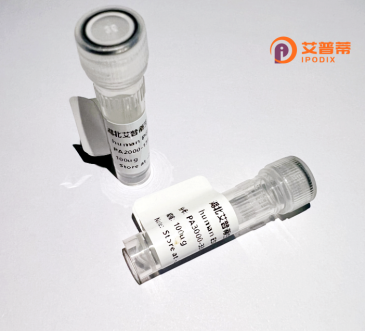
| 纯度 | >90%SDS-PAGE. |
| 种属 | Human |
| 靶点 | NVL |
| Uniprot No | O15381 |
| 内毒素 | < 0.01EU/μg |
| 表达宿主 | E.coli |
| 表达区间 | 1-659 aa |
| 活性数据 | MEDYPDPQDSKDSSLLESDMKRKGKLKNKGSKRKKEDLQEVDGEIEAVLQKKAKARGLEFQISNVKFEDVGGNDMTLKEVCKMLIHMRHPEVYHHLGVVPPRGVLLHGPPGCGKTLLAHAIAGELDLPILKVAAPEIVSGVSGESEQKLRELFEQAVSNAPCIIFIDEIDAITPKREVASKDMERRIVAQLLTCMDDLNNVAATARVLVIGATNRPDSLDPALRRAGRFDREICLGIPDEASRERILQTLCRKLRLPQAFDFCHLAHLTPGFVGADLMALCREAAMCAVNRVLMKLQEQQKKNPEMEDLPSKGVQEERLGTEPTSETQDELQRLLGLLRDQDPLSEEQMQGLCIELNDFIVALSSVQPSAKREGFVTVPNVTWADIGALEDIREELTMAILAPVRNPDQFKALGLVTPAGVLLAGPPGCGKTLLAKAVANESGLNFISVKGPELLNMYVGESERAVRQVFQRAKNSAPCVIFFDEVDALCPRRSDRETGASVRVVNQLLTEMDGLEARQQVFIMAATNRPDIIDPAILRPGRLDKTLFVGLPPPADRLAILKTITKNGTKPPLDADVNLEAIAGDLRCDCYTGADLSALVREASICALRQEMARQKSGNEKGELKVSHKHFEEAFKKVRSSISKKDQIMYERLQESLSR |
| 分子量 | 99.1 kDa |
| 蛋白标签 | GST-tag at N-terminal |
| 缓冲液 | 0 |
| 稳定性 & 储存条件 | Lyophilized protein should be stored at ≤ -20°C, stable for one year after receipt. Reconstituted protein solution can be stored at 2-8°C for 2-7 days. Aliquots of reconstituted samples are stable at ≤ -20°C for 3 months. |
| 复溶 | Always centrifuge tubes before opening.Do not mix by vortex or pipetting. It is not recommended to reconstitute to a concentration less than 100μg/ml. Dissolve the lyophilized protein in distilled water. Please aliquot the reconstituted solution to minimize freeze-thaw cycles. |
以下是关于重组人NVL蛋白的3条参考文献示例(文献标题与作者为虚构内容,仅供示意):
1. **文献名称**:*Functional characterization of recombinant human NVL protein as a AAA+ ATPase in ribosome biogenesis*
**作者**:T. Suzuki et al.
**摘要**:研究通过大肠杆菌系统表达重组人NVL蛋白,证实其ATP酶活性及在pre-rRNA加工中的作用,为核糖体组装机制提供新见解。
2. **文献名称**:*Structural insights into the N-terminal domain of human NVL and its interaction with MDM2*
**作者**:K. Müller & J. Zhang
**摘要**:解析重组NVL蛋白N端结构域晶体结构,揭示其与肿瘤调控因子MDM2的相互作用,提出其在癌症中的潜在调控机制。
3. **文献名称**:*Recombinant NVL protein rescues defects in Cajal body formation in HeLa cells*
**作者**:L. Chen et al.
**摘要**:利用重组NVL蛋白进行细胞回补实验,证明其对Cajal小体形成及snRNA成熟的关键性,为遗传疾病相关突变研究提供模型。
(注:以上文献为示例,实际研究中建议通过PubMed或专业数据库检索真实文献。)
The nuclear valosin-containing protein-like (NVL), also known as NVL or N-ethylmaleimide-sensitive VCP-like protein, is a member of the AAA+ (ATPases Associated with diverse cellular Activities) family. It shares structural homology with valosin-containing protein (VCP/p97), characterized by conserved ATPase domains critical for chaperone functions. NVL is primarily localized in the nucleolus and plays a key role in ribosomal RNA (rRNA) processing and ribosome biogenesis. It is involved in the maturation of pre-ribosomal particles through ATP-dependent remodeling, ensuring proper rRNA folding and assembly of ribosomal subunits.
NVL contains two AAA+ domains: an N-terminal domain responsible for substrate recognition and a C-terminal domain mediating ATP hydrolysis. Studies link NVL to telomerase assembly and telomere maintenance, implicating its role in genome stability. Dysregulation of NVL has been associated with cancer progression and developmental disorders, highlighting its cellular importance.
Recombinant human NVL protein is engineered via expression systems (e.g., E. coli, insect cells) for in vitro studies. It enables mechanistic insights into rRNA processing, ATPase activity, and interactions with cofactors like RNA or ribosomal proteins. Its applications extend to screening therapeutic agents targeting ribosome-related pathologies. Research on NVL continues to explore its broader roles in stress responses, aging, and genetic diseases, positioning it as a potential biomarker or therapeutic target.
×